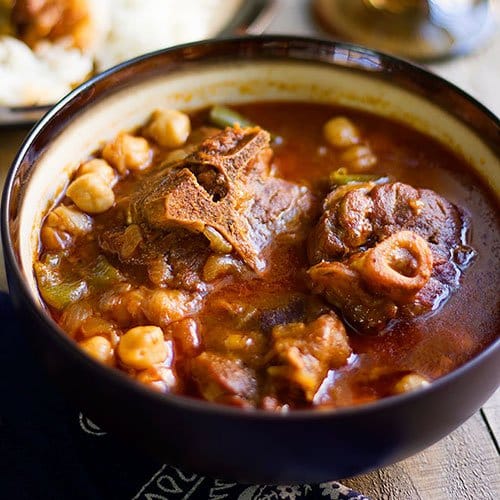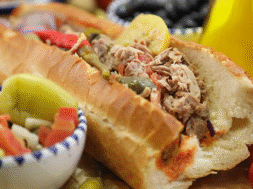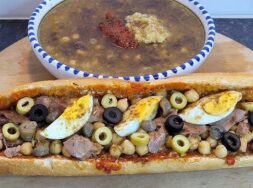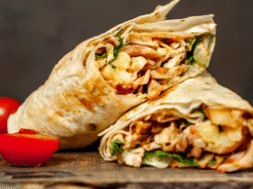Tunisian Lamb Marqa: A Stew Full of Flavor and Tradition
In Tunisia, Marqa (sometimes spelled marka) is the heart of many family meals — a slow-simmered stew of meat, tomatoes, spices, and vegetables. It’s not just food, it’s comfort in a pot. Unlike couscous, where the sauce is poured over semolina grains, marqa stands on its own as a dish, eaten with bread or served alongside couscous for a complete feast.
Our first taste of lamb marqa came in Monastir, at a small local restaurant where the steam from the pot fogged up the windows. The stew was rich with tomato, tender chunks of lamb fell apart on the spoon, and every bite carried cumin, coriander, and just the right kick of harissa. It wasn’t just filling — it was soulful.
Marqa is a versatile dish. Some days it’s lamb with root vegetables, other days chicken with chickpeas, or even fish simmered in tomato and spice. It adapts to what’s available and to the season. In winter, the stew is thick and warming; in summer, it can be lighter with zucchini and peppers.
What makes marqa so distinct is the spice balance — bold yet not overwhelming. Harissa adds heat, tomato paste gives depth, and cumin and coriander bring that unmistakable North African aroma. It’s the kind of dish that fills not just the stomach, but also the home with its scent.

What is Tunisian Marqa made of?
The base of marqa is meat (often lamb or chicken), tomatoes, olive oil, garlic, and spices like cumin, coriander, paprika, and turmeric. Vegetables such as carrots, potatoes, or chickpeas are added depending on season and preference.
Is Marqa the same as couscous?
Not exactly. Couscous refers to the semolina grains, which are often served with a sauce similar to marqa poured over them. But marqa can also be eaten on its own, with bread to soak up the sauce. Think of couscous as a dish, and marqa as the sauce or stew that often accompanies it.
Is Tunisian Marqa spicy?
Yes, but the level of spice depends on the cook. Harissa is almost always included, giving marqa its signature heat. Some versions are mild, while others pack a real kick.
What meat is best for Marqa?
Lamb is traditional, especially for family meals and celebrations. Chicken is also common, while coastal areas may prepare marqa with fish. Each variation is delicious in its own right.
Is Tunisian Marqa healthy?
Marqa is a wholesome dish. It’s rich in protein from lamb, packed with fiber from chickpeas and vegetables, and flavored with olive oil and spices. While hearty, it’s not heavy — making it both nourishing and comforting.
When do Tunisians eat Marqa?
Marqa is eaten year-round, often on Fridays for family meals, during Ramadan, and at gatherings. It’s a dish that scales easily, feeding small families or big groups.
Share this recipe
Tunisian Lamb Marqa (Spiced Lamb Stew)

NUTRITION
Ingredients
- 600 g lamb shoulder or shank, cut into chunks
- 3 tbsp olive oil
- 1 large onion finely chopped
- 3 cloves garlic minced
- 2 tbsp tomato paste
- 2 medium tomatoes grated or chopped
- 1 tsp harissa adjust to taste
- 1 tsp ground cumin
- 1 tsp ground coriander
- 1 tsp paprika
- ½ tsp turmeric
- ½ tsp cinnamon optional
- 4 cups water or stock lamb/chicken/vegetable
- 1 cup cooked chickpeas optional but traditional
- 2 carrots sliced
- 2 potatoes cubed
- Salt and black pepper to taste
- Fresh parsley or cilantro chopped, for garnish
- Lemon wedges to serve
Instructions
- Brown the lamb: In a heavy pot, heat olive oil and sear lamb chunks on all sides until browned. Remove and set aside.
- Make the base: In the same pot, sauté onion until golden. Add garlic, tomato paste, and harissa, cooking until fragrant.
- Add tomatoes and spices: Stir in grated tomatoes, cumin, coriander, paprika, turmeric, and cinnamon. Cook for 2–3 minutes until the sauce thickens.
- Simmer: Return lamb to the pot, add stock, and bring to a boil. Reduce to a simmer and cook covered for 45 minutes.
- Add vegetables & chickpeas: Stir in carrots, potatoes, and chickpeas. Simmer another 30–40 minutes until lamb and vegetables are tender.
- Season & serve: Adjust seasoning with salt and pepper. Garnish with parsley and serve hot with couscous or bread, plus lemon wedges on the side.




